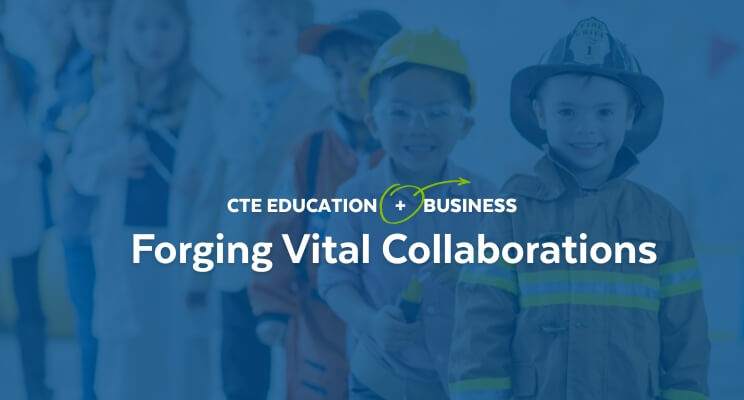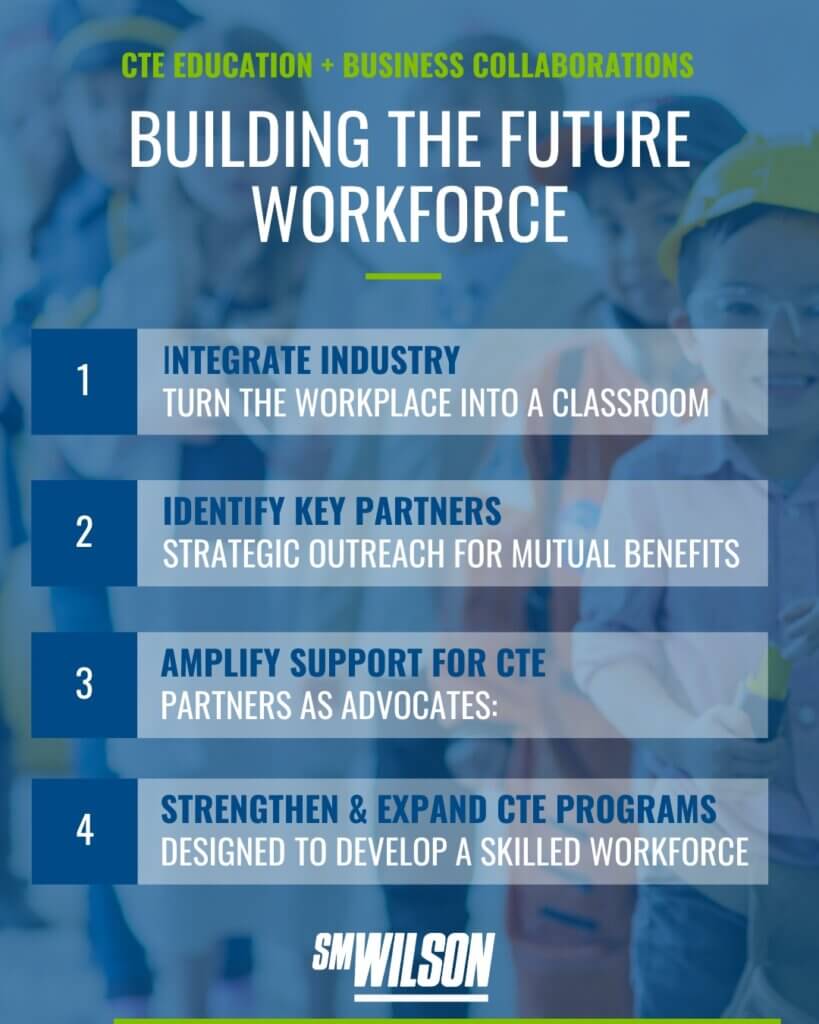Building the Future Workforce

Forging Vital Collaborations for Stronger Communities & Brighter Career Paths
As education administrators and board members, you are charged with preparing students for a future defined by rapid change while simultaneously addressing the urgent demands of our economy.
Today, one of the most pressing challenges is a profound skilled labor shortage, particularly in foundational industries like construction, where over 41% of the U.S. workforce is expected to retire by 2031.
This isn’t just an industry problem; it’s a community crisis that impacts our ability to build homes, schools, and infrastructure.
But within this challenge lies a win-win opportunity. The solution is to strategically strengthen and expand Career and Technical Education (CTE) programs through meaningful community partnerships.
This approach directly addresses the workforce crisis by creating a reliable talent pipeline while preparing our students for the fulfilling, stable futures they seek—futures that align with their core aspirations for “security and meaning.”

By forging vital collaborations, education leaders can build stronger communities and bright career paths for students by:
- Enhancing career pathways
- Aligning curricula with industry needs
- Ensuring the long-term sustainability of CTE programs
CTE: Preparing Students for Life, Not Just a Job
The new generation of CTE offers a tangible solution that transforms a workforce crisis into a generational opportunity. When done right, CTE is a powerful engine that delivers what employers desperately need—“proven performers”—and what learners crave—a “future they can count on.”

Fueled by federal policies like Perkins V and a growing recognition of its effectiveness, CTE participation has expanded significantly in recent years. No longer an alternative track, it provides essential relevance and application to academic learning, answering the perennial student question: “Why do I need to know this?”
Modern CTE’s value is in connecting abstract concepts in math and science to the real world. CTE is not a departure from academic rigor; it is the application of it. CTE develops both the technical skills for specific trades (like construction, IT, and healthcare) and the essential “soft” skills—communication, problem-solving, teamwork—that employers universally seek.
Research confirms that CTE keeps students engaged, leads to higher graduation rates, increases enrollment in two-year colleges, and provides a strong foundation for four-year education paths. Furthermore, CTE benefits groups facing systemic barriers, including low-income students, students of color, and students with disabilities, often improving high school completion rate.
The value of high-quality CTE education helps districts fulfill their mission, as illustrated in Pattonville School District’s stated approach to ensure graduates are “ready for success in life and equipped to thrive in a constantly changing world — whether the next step leads to college, career, or additional training and apprenticeships.”
1. Integrate Industry: Turn the Workplace into a Classroom
The most effective CTE programs are not theoretical. They are deeply aligned with the industries they serve, breaking down the walls between the classroom and the workplace.
The origin of S. M. Wilson’s SKILLED program, a construction-focused career education initiative, is a perfect case study. The program began when founder Amanda Bohnert was walking her preschooler through a high school under construction and her son stopped, mesmerized by an electrician.
“My son’s preschool was housed inside a local high school that happened to be under construction. One morning, as I rushed him down the hall, he stopped and stared at an electrician wiring the ceiling. I paused too — and realized what an incredible opportunity for career exposure was happening right there, just outside the classroom door,” Bohnert recalls.
That single moment of a child’s curiosity sparked an idea that has become a cornerstone of effective industry collaboration: turning an active job site into a “living classroom.” Since its inception, SKILLED has impacted more than 20,000 students.

Meaningful partnerships move beyond career fairs and into the core educational experience. Key best practices include:
>> Co-Develop Curriculum
Research confirms that student outcomes improve when employers provide input. Invite industry leaders to help shape what is taught by serving on curriculum advisory boards. The greatest impact comes from partners who “co-develop curriculum,” ensuring alignment with current standards and technologies.
>> Create Clear On-Ramps to Work-Based Learning: Internships, pre-apprenticeships, and apprenticeships are crucial for building skills and social capital. School districts can increase student awareness of these opportunities and prepare students for the application process.
>> Bring Expertise into the Classroom
Create opportunities for industry professionals to serve as guest instructors, project mentors or competition judges. This gives students direct access to expert knowledge and valuable real-world perspectives.
>> Utilize Partner Resources
Leverage partnerships for equipment donations, software access, facility tours, and funding for industry-recognized credentials. This enhances program quality while reducing district costs.

2. Identify Key Partners: A Framework for Strategic Outreach
Forging community partnerships requires a proactive effort led by district administrators and board members. Find partners who see collaboration not as a charitable act but as a core business strategy.
The key to initiating these collaborations is to start with a simple ask to first build trust. This can be as straightforward as inviting a potential partner on a tour of your school. As the relationship grows, focus on how the partnership can address their specific workforce challenges by creating a pipeline of skilled, motivated future employees.
“Partnerships between education and industry are more than workforce solutions, they’re community investments. By connecting classrooms to careers, we give students purpose, local employers a pipeline of talent, and our communities a stronger future,” said Dr. Katie Siegel.
Schools can find organizations with a mutual interest in developing local talent by:
- Analyzing Local Workforce Needs: Identify the industries in your region facing the most significant skills gaps. These businesses don’t just want to partner; they need to.
- Leveraging Industry Associations: Connect with local chapters of trade organizations like the Associated General Contractors (AGC). These groups act as gateways to numerous member companies eager to engage.
- Engaging Postsecondary Institutions: Collaborate with natural allies like community colleges and technical schools on dual enrollment programs, articulated credits, and joint outreach to industry.
- Looking Inward: Parents, alumni, and companies already servicing your district are a rich, often untapped, source of potential partners.
3. Forge Vital Collaborations for Stronger Communities & Brighter Caerer Paths
Once engaged, your community partners become your most powerful advocates for policy and funding. Their perspective, which represents the “demand” side of the economy, carries immense weight with policymakers and school boards.
Administrators and boards can empower partners to be effective advocates by:
- Arming Them with the Business Case: Equip partners with district-specific data and compelling student success stories. Encourage partners to testify about how the skills gap causes project delays and increases costs, presenting CTE funding as an essential economic development investment.
- Mobilizing Testimony: Encourage partners and their CTE-hired employees to share their experiences at public meetings. This provides real-world validation that these programs work, giving leaders the confidence to invest public funds.
- Championing Systemic Policy Changes: Engage partners to advocate for state and local policies that support the entire CTE ecosystem — dedicated funding for career navigation programs, streamlined credentialing, and incentives for companies that invest in apprenticeships and work-based learning.
4. Strengthen and Expand CTE Programs
By strengthening Career and Technical Education, education and business leaders have the opportunity to co-architect a skilled workforce of former students who are motivated and prepared to thrive. It comes down to establishing collaborative strategies and fostering the transformative power of applied learning.
Sustaining and growing high-quality CTE requires support from students, families, and the community. To achieve this, districts can:
- Reframe the Narrative:
Use what research calls “Winning Words” to dismantle the outdated stigma that career education is an “alternative to college.” Frame it as a “buildable path” to a “future they can count on“—a smart, flexible option for all ambitious students. - Implement Robust Career Navigation:
Research shows that while a majority of learners are interested in these pathways, less than a quarter feel they know how to get started. Districts must establish comprehensive career advising systems to provide clear and personalized guidance, beginning in middle school. - Share “Social Proof”:
While data is important, stories change minds. The single most effective way to convince a young person a path is viable is to show them real stories from other people who have found successful careers.
When a student sees a recent graduate thriving as an electrician or project manager, the abstract becomes achievable. It shifts the narrative from being “for someone else” to being “for me.” Also, share these testimonials prominently in all district communications.

This article was based on the S. M. Wilson-hosted “Supporting Career and Technical Education (CTE) Through Community Partnerships” session at the 2025 Missouri School Board Administrators (MSBA) Annual Conference. Designed for education administrators and boards of education, the session explored strategies for strengthening Career and Technical Education (CTE) programs through meaningful community partnerships.
Resources
To learn more about the power of community partnerships and how to foster such a partnership in your school, explore these resources:
Research
Research references in this article were obtained from:
>> How Apprenticeships Empower Adult Learners and Bridge the Construction Workforce Gap — National Center for Construction Education and Research
>> From Insights to Action: Communicating Career Pathways With Confidence by Pathways and Workforce Funders

